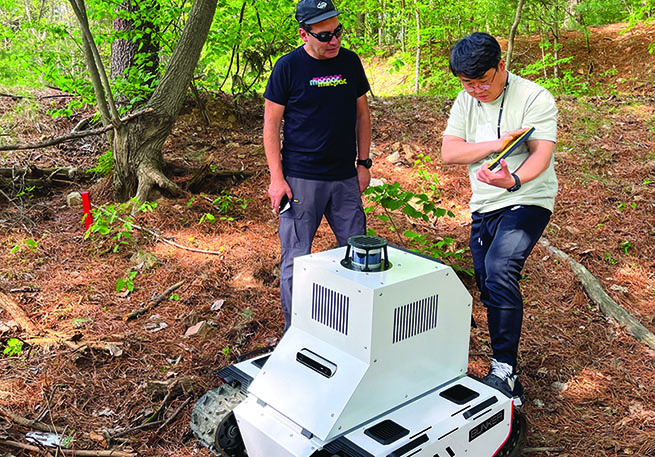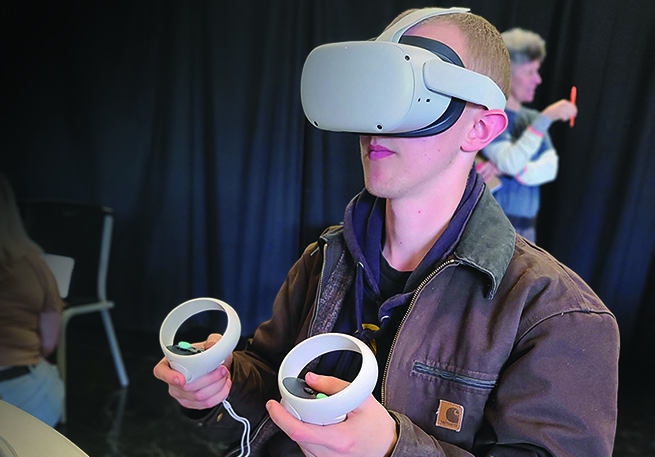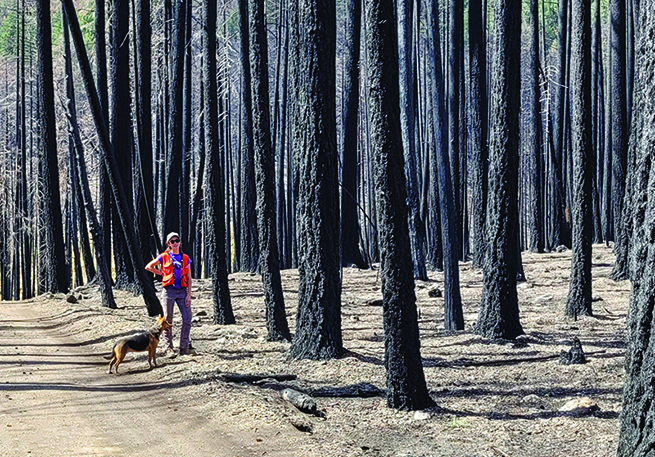Optimizing maple syrup production in the PNW
The College of Forestry Maple Lab, led by Eric Jones, instructor and assistant professor of practice, has several new experiments underway. The first is work on affordable, small-scale ultrafiltration and ultraviolet light systems to control microbial growth that can spoil fresh sap before it is processed into maple syrup. The team includes food science Ph.D. student Andrea Domen and COF courtesy faculty Brian Kearney. Early results are promising and producers could be incorporating the technology in their production systems as early as winter 2025.
Professor Emeritus Barb Lachenbruch is leading a second area of research on sap flow dynamics using vacuum chambers developed and custom built by Garth Jensen and Art Myers, two facility and operations staff at the college. This study explores how additional tap holes affect vacuum pressure and sap collection quantities, particularly considering tree responses such as internal pressure loss from leaks and the formation of nonconductive wood. Findings from this research will help producers improve tap hole management for greater sap production without compromising overall tree health.
And finally, Professor Chris Still installed automatic point dendrometers on maples at a producer partner site outside Sheridan, Oregon, as an exploratory test for including Acer macrophyllu m in his studies on heat stress in Northwest trees. The data is proving valuable and the research recently expanded to include maples at other properties outside Marcola , Oregon. This research is crucial for understanding how heat stress from events like heat domes contributes to our overall understanding of climate change in the Pacific Northwest, and researchers hope the findings will help maple syrup producers anticipate and plan for impacts on their maple trees.
COF enrollment surges - The numbers are in and we’re proud to report that the college experienced record growth last fall with enrollment surging by 9% compared to Fall 2023. Undergraduate enrollment rose by 8% and graduate enrollment grew by an impressive 16%. This is particularly significant considering that, over the past decade, annual growth has typically been in the range of 1-3%. We’d like to acknowledge the incredible efforts of our faculty, staff and specifically the student services team, whose support and hard work have been crucial in helping our students join the college community and pursue a life-changing education.
Supporting food security for students - Last October, the college again hosted a crowdfunding campaign to raise money for the student food pantry Rootstock. Our incredible community donated a total of $16,433 to
help keep the pantry stocked for another year. Special thanks to Heath Webb (‘13), a hardware testing engineer, who helped secure a $5,000 matching donation from his employer Trimble, a construction technology provider. In December, the college also hosted its third annual “Bobbin’ Through the Woods” Craft Fair, which raised another $7,000 thanks to the support of more than 30 vendors who participated in the show.
Harnessing technology to monitor an uncertain future
Oregon just experienced its driest 20-year-period in the last millennium, and the combined impacts of drought and heat stress on Oregon forests are of great concern to scientists, land managers and the public alike. A multidisciplinary project at the OSU ponderosa pine AmeriFlux sites near Sisters, Oregon, is using advanced systems and sensors technology to probe plant function at remarkably fine spatial scales. Harnessing this technology holds immense potential for estimating carbon uptake, monitoring forest resilience, managing forests and improving ecosystem models.
Assistant Professor German Vargas is deploying sensors that measure the attenuation of microwave radiation from global navigation satellite systems, revealing the complex ways in which plant canopies store and use water. Similarly, Charlie Southwick, a Ph.D. student working with Assistant Professor Loren Albert, is combining thermal and solar-induced chlorophyll fluorescence imagery to understand how photosynthesis responds to temperature stress and water limitation. These “near-surface” remote sensing technologies pave the way for real-time, dynamic monitoring of Oregon’s forests, from now into an uncertain future. While satellite remote sensing has for decades revealed broad scale forest patterns and processes, this new technology allows researchers to probe plant function at a finer scale, crucial to understanding, monitoring and improving our forests in the face of climate change.
Alumni updates - New job, promotion or baby? Or maybe you’ve recently retired? Do you have a new business venture, research find or accomplishment? Whatever it is, we want to hear your good news! Take a moment to connect with us using this form. All entries receive a free College of Forestry Alumni sticker!
Dam Proud Day - Show up for COF on April 30, 2025! Once a year, Beavers from around the globe come together for Dam Proud Day, an annual 24-hour online fundraising event dedicated to building a better, stronger, more influential Oregon State University. Get more information about Dam Proud Day.
Dean's dinner – Join us as we recognize College of Forestry scholarship recipients, outstanding alumni and donors on Thursday, May 22, 2025, at 5:00 p.m. in the CH2M Hill Alumni Center at Oregon State.
Commencement will be held on Saturday, June 14, at Reser Stadium in Corvallis. Save the date to celebrate the class of 2025!
Show your COF pride! Check out our merch store.





